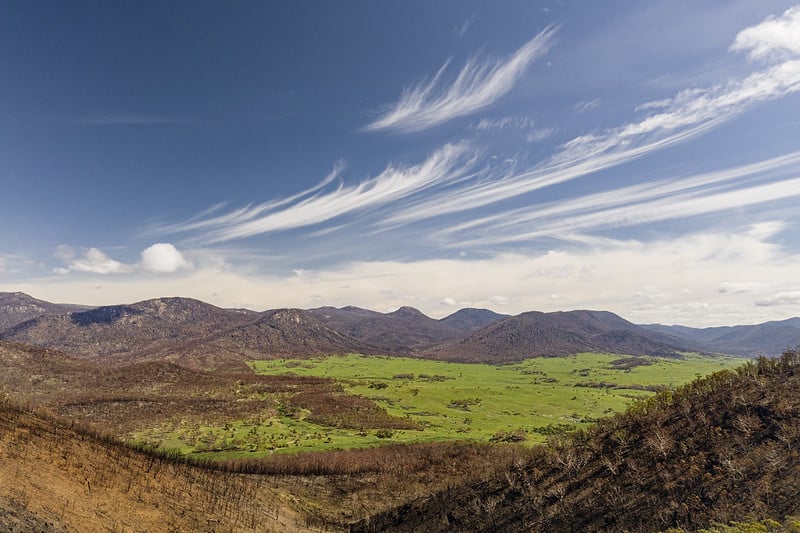Almost three years ago, the ACT suffered “one of the biggest ecological disasters in [its] history”, in the words of the Australian Institute for Disaster Resilience (AIDR): the Orroral bushfires of January 2020 that ravaged Namadgi and Tidbinbilla. The damage was incredible, Mick Gentleman, ACT Minister for Planning and Land Management, said – but the ecosystems have slowly recovered. Now, a $6 million grant from the Commonwealth’s Black Summer Bushfire Recovery Fund will help the government to improve damaged parks, walkways, and infrastructure.
“This means we can build back better, using better equipment and materials, so they can last longer and will be more sustainable,” Mr Gentleman said. “Canberrans love their nature parks across the ACT. It will be great to open them back up for Canberrans to enjoy, particularly over the summer period.”
The ACT Government will use the grant to:
- repair and upgrade roads so they are more accessible for land and fire management;
- upgrade the Yankee Hat walk, working with Ngunnawal people to ensure culturally appropriate and respectful access and interpretation;
- extend the walking track along Honeysuckle Ridge through the Granite Tors and around the Orroral Geodetic Observatory;
- commemorate and interpret two heritage-listed stockmen’s huts destroyed by fire;
- upgrade Booroomba, Gibraltar Falls, and Woods Reserve visitor precincts.
Work will begin in 2024.
“Once we finish, the park will be spectacular,” said Peter Cotsell, director of the Namadgi and Tidbinbilla national parks.
There will also be more services for people with disabilities, such as an accessible loop trail around the Namadgi Visitor Information Centre, so they can enjoy the scenery, the birds, and the beautiful grass wetlands, Mr Cotsell said; or camping spots at Honeysuckle Ridge where wheelchair-bound people can enjoy the stars. (There are already disability barbecues at the Cotter Reserve, and a 1.2 km trail at Tidbinbilla.)
Announcing the funding, David Smith MP said that as a walker, he looked forward to getting back to places like Yankee Hat. The ACT often missed out on support, he remarked, because it is not thought of as a regional area; the new federal government recognises that while Canberra is a city, the ACT is a rural and urban environment.
The Orroral fires were “the most serious fire Canberra had faced since the deadly 2003 fires”, the AIDR states. The fire started in Namadgi on 27 January 2020, when an army helicopter’s searchlight accidentally sparked a fire in dry grassland. (The crew wanted a toilet break.) The fire quickly spread in record dry conditions, hot temperatures, and gusty winds. It burnt almost 88,000 hectares throughout the ACT: 80 per cent of Namadgi national park (82,700 hectares), 22 per cent of Tidbinbilla (1,444 ha.), and 3,350 ha. of rural lands. The fire was finally declared out on 27 February.
- Orroral Valley bushfire inquest told army helicopter started blaze (14 November)
- National Parks recovering one year after Orroral Valley fire (27 January 2021)
Twelve months later, Mr Gentleman remembered, the parks were still incredibly damaged, but he took hope from little shots of bright green coming out of the black scarred trees.
Bogs and fens have been restored, while there has been a lot of recovery throughout the catchment, Mr Cotsell said: stabilisation through native grasses and shrubs; regeneration of fire-affected trees and saplings; and regrowth. 2022 has been a great year for orchids and wildflowers, for instance.
Threatened species like the broad-toothed rat are returning to the area, while invasive weeds and feral animals have been controlled.
Most walking tracks have since been reopened, including the Mt Tennent walk. Over the last two years, Mr Gentleman said, Parks ACT have done “an incredible job” to restore walking tracks, often better than they were before the fire. Old timber steps have been replaced with solid stone steps that will not erode, for instance.
Mr Cotsell is not sure the park will ever be what it was in 2018. Over the next few years, he predicts, the canopy will come back, but the ecosystem will change, due to climate change: more extreme weather events, higher temperatures, and the threat of bushfires.
“With climate change, with the challenges we face at the moment, it might be going through a transition to something completely different – we’re not sure…”
What it will look like in three decades depends on dry cycles, fires, floods, and the amount of rain.
Parks ACT will monitor the environment for bushfires. The ACT, Mr Gentleman said, now has sensors that can detect lightning strikes, and geothermal cameras in towers that can look down at where the lightning strike occurred, understand whether a fire has started, and send RAAF teams or ground teams to put out the fire or patrol them.
“A wonderful asset for us to look after bushfires – it will help us control bushfires when they occur,” Mr Gentleman said. “If we had this technology for the 2003 fires, we would have known what was coming, and been able to deal with it earlier.”



